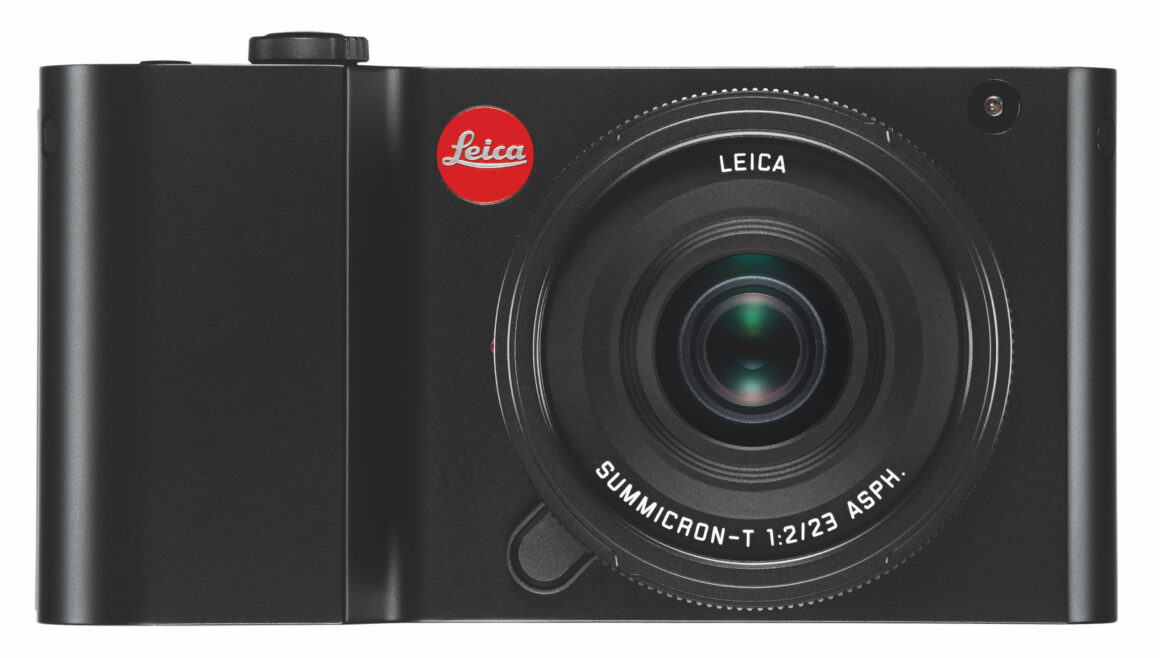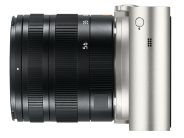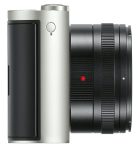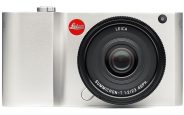Leica T (Typ 701)
APS-C AF digital mirrorless camera
Specification
| Production details: | |
| Announced: | April 2014 |
| Order No.: | 18180 - black |
| 18181 - silver | |
| System: | ● Leica L APS-C (2014) |
| Format: | |
| Maximum format: | APS-C |
| Imaging sensor: | 23.6 × 15.7mm CMOS sensor |
| Resolution: | 4944 × 3278 - 16 MP |
| Crop factor: | 1.53x |
| Sensor-shift image stabilization: | - |
| Mount and Flange focal distance: | Leica L [20mm] |
| Shutter: | |
| Type: | Focal-plane |
| Model: | Electronically controlled |
| Speeds: | 30 - 1/4000 + B |
| Exposure: | |
| Exposure metering: | Through-the-lens (TTL), open-aperture |
| Exposure modes: | Programmed Auto |
| Aperture-priority Auto | |
| Shutter-priority Auto | |
| Manual | |
| Physical characteristics: | |
| Weight: | 384g |
| Dimensions: | 134x69x33mm |
| Accessories: | |
| Body cap: | 14028 (TL) |
Manufacturer description
Solms, Germany, 3rd April 2014, Leica Camera AG presents a new camera system that combines the fine art of engineering and hand-crafted excellence with design and handling in an entirely new and innovative concept. From the initial idea through to the development process and in its final assembly, the focus of all disciplines involved was on one single thing – perfection. The outcome was the creation of the Leica T-System, a camera with an exquisite finish ‘made in Germany’ that, together with a portfolio of precise, high-performance lenses, offers exceptional versatility and particularly intuitive handling. Unique in design and pared down to the essential functions, the new Leica T-System offers everything anyone could ever need for pure, creative photography and the best image quality.
In collaboration with AUDI Design, the typical design language of Leica cameras was revisited and reinterpreted. With its timeless and sleek design, the Leica T picks up the unmistakeable attributes of Leica product design and develops them systematically – with clean lines, smooth surfaces and formal minimalism. One of the camera’s outstanding features is its compact and solid body. This is manufactured with innovative precision techniques from a single block of aluminium at the Leica factory. The use of premium materials and their processing in an elaborate manufacturing process are unique in the history of camera construction and lend the Leica T an unmistakeable look, feel and solidity. Its substantial weight and a newly developed operating concept underline its user-friendly handling and, together, these features ensure an incomparable photographic experience.
Two lenses will initially be available for the market launch of the Leica T-System. The Leica Vario-Elmar-T 18–56 mm f/3.5–5.6 ASPH. is ideal for creative experimentation with various perspectives and focal lengths. For expansive landscapes, documentary pictures or portraits – whatever the genre, this standard zoom lens offers exceptional flexibility in every situation. With a focal length equivalent to 35 mm in full-frame format, the fast and compact Leica Summicron-T 23mm f/2 ASPH. offers a truly classic Leica focal length that is ideal for reportage photography. The Super-Vario-Elmar-T 11–23 mm f/3.5–4.5 ASPH. wide-angle zoom and the Vario-Elmar-T 55–135 mm f/3.5–4.5 ASPH. telephoto zoom are scheduled to appear in time for presentation at photokina 2014. Developed by Leica optical designers as precision tools, all Leica T lenses offer the exceptional imaging performance for which Leica lenses are famed.
The combination of a newly designed high-performance processor and sensor ensures outstanding picture quality in every situation. The Leica T features a large, APS-C-format, CMOS image sensor with over 16.5 megapixels (effective 16.2 MP) that, due to its size, performance and imaging characteristics, represents the ideal solution in the compact class of the Leica T. It ensures brilliant pictures with outstanding contrast, finest detail resolution and natural colour rendition – even in unfavourable lighting conditions.
Complementing the purist design of the camera, the operating concept of the Leica T is equally clear, simple and concentrated on relevant functions. At the heart of the concept is the clear design of the touchscreen display. It is generously dimensioned and generates a bright and clear image that allows precise and reliable assessment during image composition and in playback mode. Numerous functions in capture and playback mode can be controlled simply by touching the screen. The only other controls are four ergonomically positioned haptic control elements that are intuitive in their operation. This ensures that camera users can concentrate fully on composing their pictures – without any unnecessary distractions. The MyCamera menu of the Leica T offers even greater flexibility, even for spontaneous snapshot situations, and can be configured and programmed with settings to meet the user’s own personal requirements. This means that the photographer always has fast access to the most frequently used features and presets.
The Leica T is the first system camera from Leica to feature an integrated Wi-Fi module. Pictures and videos can be wirelessly transmitted straight from the camera to a smartphone, tablet or computer, and can then be shared by email, or on Facebook or other social media. A free Leica T app for iOS devices is available now. A particularly practical feature of the app is the remote function. This lets users wirelessly connect their smartphone or tablet to the camera and use it as an electronic viewfinder for the Leica T and, amongst other functions, allows remote setting of the shutter speed and aperture values – for example for shots with the self-timer function or from unusual angles.
The Leica T-System also offers a multitude of accessories. Developed especially for the Leica T-System, and perfectly harmonised with the camera, is the high-resolution electronic viewfinder with a selectable, integrated GPS feature. Its tilt and swivel function makes it particularly practical for creative photography and enables shooting from different viewpoints and unusual angles. Also available is the new Leica SF 26 flash unit, which provides additional opportunities for flash exposures or fill-in flash for brightening subjects. The angle of the flash reflector is adjustable. Whenever needed, the unit can even be used as an LED light source for video recording. Another practical accessory is the Leica M-Adapter T, which allows users to mount and use Leica M-Lenses on a Leica T body. The adapter features a sensor for 6-bit coded M-Lenses. This fully supports Leica T functions such as exposure metering, aperture priority mode and manual setting capability.
Further camera accessories in four trendy colours – melon yellow, orange-red, black and white – and an extensive range of premium bags and cases, all of them courtesy of AUDI Design, systematically continue the Leica system concept. Individual accessories build on and complement one another, and some offer unique options for personalised combination.
With its materials mix of hard plastic and elastic silicone, the Leica T-Snap for the front of the camera provides optimum protection against scratches and inadvertent knocks. Its unique design lends the camera an eye-catching and personalised look. The soft silicone T-Flap is the ideal complement to the T-Snap. It clicks easily into the T-Snap to protect the back of the camera with the display screen and controls when the Leica T is not in use. The design and colours of the carrying strap and wrist strap are perfectly matched to the modern T-Snap and T-Flap accessories. Both can be attached to the Leica T by Easy-Click, a system for connecting accessories to cameras that is unique throughout the world. True to the clean and uncluttered design concept of the camera, protruding strap lugs have been omitted. Carrying straps and the wrist strap now fuse with the camera to create a single entity and can be detached in a flash. The range of accessories for the Leica T also offers a leather holster, a leather protector and a system bag.
The Leica T is available May 26th, 2014 from Leica Store Mayfair and authorised Leica dealers. The range of accessories will be available following the launch of the camera.
Adobe® Photoshop® Lightroom®, a professional digital workflow solution for Apple Mac® OS X and Microsoft Windows®, is also included in the Leica T package. This digital image processing software offers a comprehensive range of functions for the management, processing and presentation of still pictures and video recordings. Leica customers can download the software free from the Leica website after registering their camera.
Special limited editions (1)
- Leica T (Typ 701) "Chalie Vice" (50 units) - February 2016





